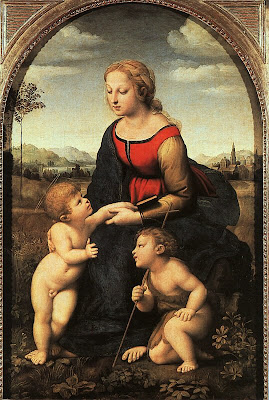Why did the Renaissance painters choose the theme of the Madonna with the child Jesus and the boy John the Baptist? I think because it is a charming and attractive theme in itself, but it is also a meditation on a deeper aspect of the mystery of the incarnation.
Here we see the two boys and remember that the world’s redeemer and the prophet of all prophets were once little children. They were cousins and playmates, and it is a reminder that Christ Jesus took on the full experience of the human condition. It is also a reminder that we too must become like little children if we are enter the kingdom. He became a child so that we can become children.
But there is more to this picture: the Blessed Virgin is seated between the two boys. One who sums up the Old Testament dispensation and the other who incarnates the new covenant. St John the Baptist is down and lower because he must decrease while Christ must increase. The Old Covenant–the law and the prophets will be fulfilled by his cousin, and while the Virgin is the larger and more central figure, her gaze, the gaze of John the Baptist and the triangular composition of the painting direct our attention to the beautiful head of Christ.
The great gift that the masterpieces of Catholic art give us is the gift of contemplation. As Mary ‘pondered these things in her heart’ our great Catholic pictures invite us to ponder these things in our art. Finally, we are to move from meditation on the truths in the pictures to the wonder of the incarnation.
Paintings like this one should move us from discursive meditation and understanding into the mystery of the incarnation and into the wordless wonder of contemplation.







Leave A Comment
You must be logged in to post a comment.